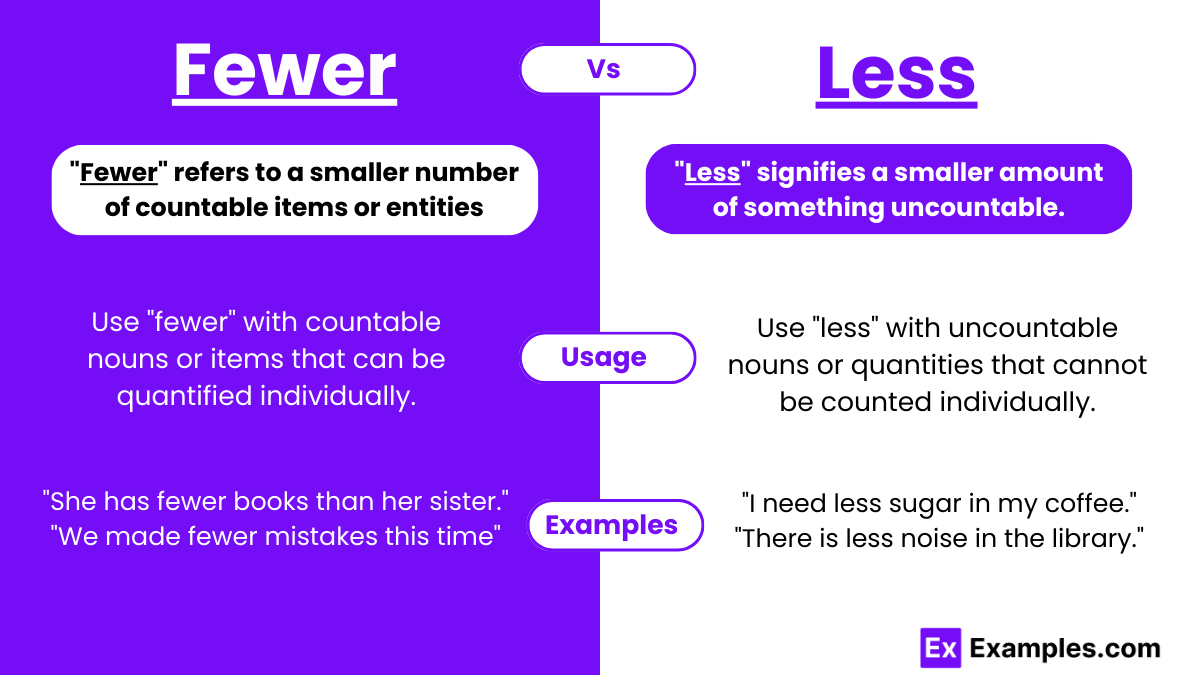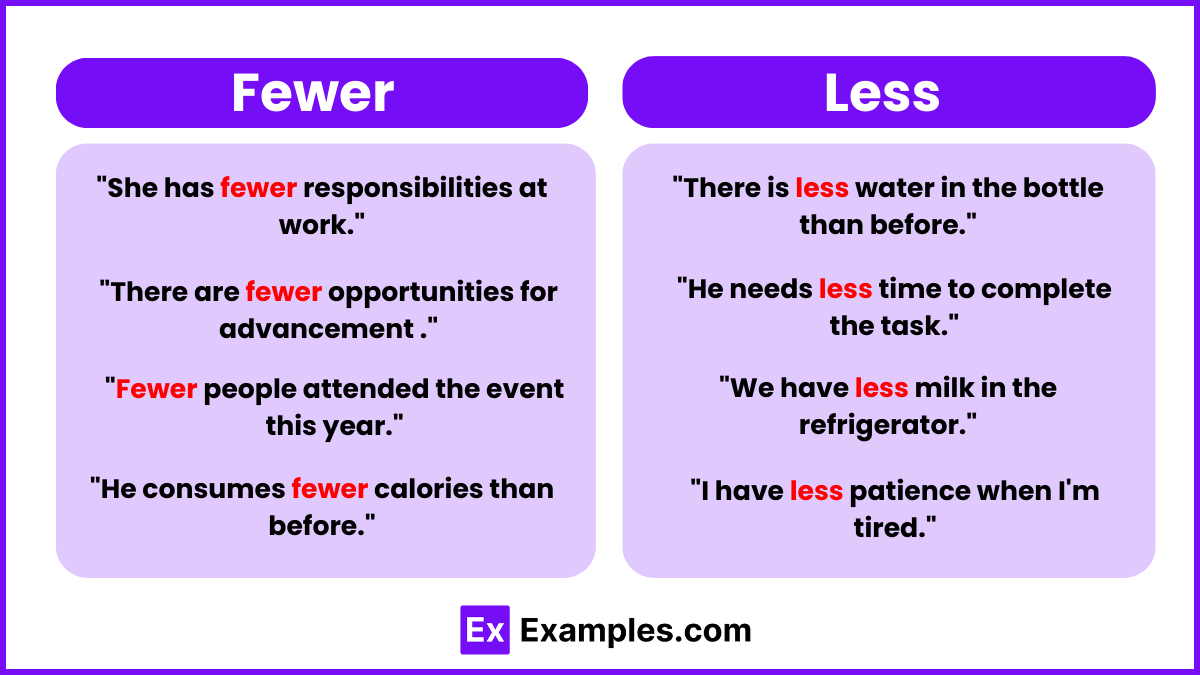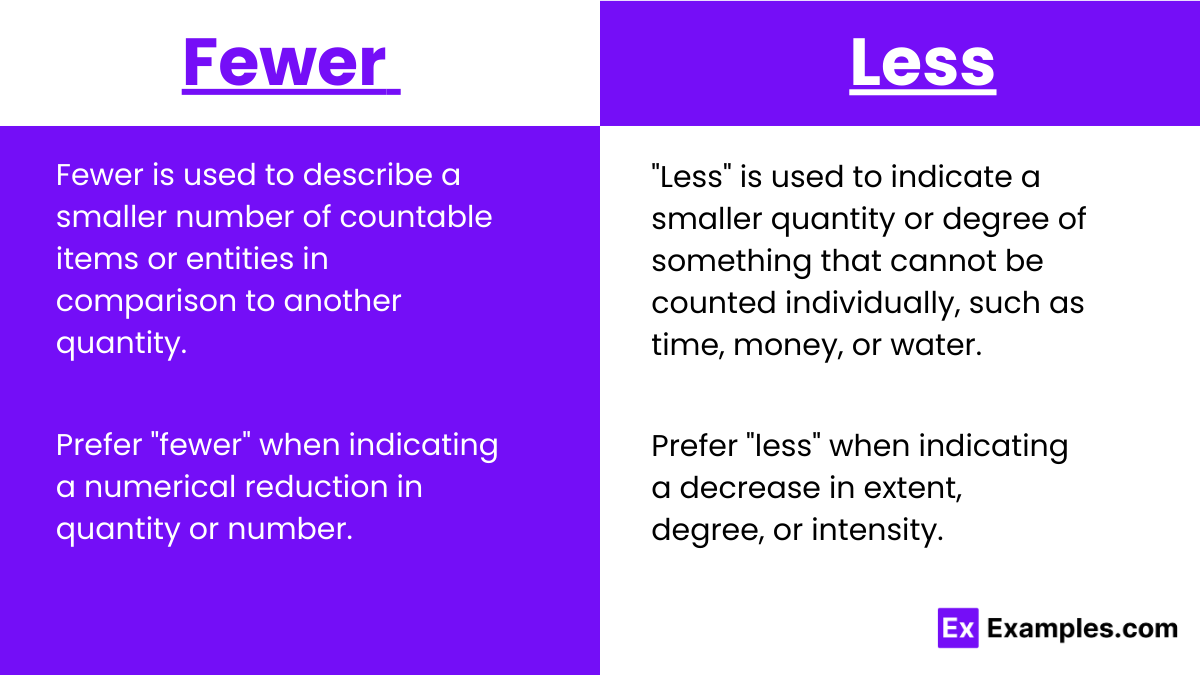Fewer vs Less – Examples, Differences, Usage, Tips
In the intricate tapestry of language, few distinctions evoke as much curiosity and confusion as the contrast between “fewer” and “less.” These seemingly innocuous words hold the key to precise communication, yet their nuances often elude even the most seasoned wordsmiths. For students navigating the labyrinth of grammar rules, understanding the subtle differences between “fewer” and “less” can be a formidable task, yet it unlocks a gateway to clearer, more effective writing.
At its core, the distinction between “fewer” and “less” lies in the realm of quantity versus degree. While “fewer” pertains to items that can be counted individually, “less” refers to quantities that cannot be quantified discretely. This fundamental disparity guides us in choosing the appropriate term to convey our intended meaning accurately. In this article, we embark on a journey through examples and explanations, illuminating the intricacies of “fewer” and “less” to equip students with the linguistic tools needed to navigate the realm of grammar with confidence and precision.
Fewer and Less – Meanings
Fewer: “Fewer” refers to a smaller number of countable items or entities. It is used when referring to quantities that can be quantified individually and compared in terms of numerical value. For example, “There are fewer apples in the basket than oranges.” This term highlights a reduction in the quantity of specific items or entities, indicating a decrease in number or amount.
Less: “Less” denotes a smaller amount or degree of something that cannot be counted individually. It is used to describe quantities that are measured in bulk or in a continuous manner. For instance, “She has less patience than her sister.” This term emphasizes a decrease in extent, degree, or intensity, rather than a specific numerical reduction.
Summary
The commonly repeated rule distinguishing between “fewer” and “less” serves as a guiding principle in language usage. “Fewer” pertains to countable items, such as “fewer choices” or “fewer problems,” while “less” denotes quantities or amounts measured in bulk, like “less time” or “less effort.” This guideline underscores the distinction between numerical reduction and a decrease in extent or intensity, facilitating clear and accurate communication in writing and speech
Difference Between Fewer and Less
Navigating the nuances between “fewer” and “less” is essential for precision in language use. Here, we dissect their differences, shedding light on when to use each term accurately in various contexts.
| Aspect | Fewer | Less |
|---|---|---|
| Usage | Refers to countable items or entities. | Describes quantities or amounts measured in bulk or continuous manner. |
| Countability | Applies to items that can be counted. | Pertains to things that cannot be counted individually. |
| Example | “Fewer apples” | “Less water” |
| Numerical Reduction | Indicates a decrease in number. | Signifies a decrease in extent or intensity. |
| Comparison | Used when comparing numerical values. | Employed when measuring amounts or degrees. |
| Context | Commonly found in sentences involving comparisons or quantifiable entities. | Typically used in contexts relating to bulk quantities or non-quantifiable concepts. |
| Countable Nouns | Accompanies plural countable nouns. | Often used with singular uncountable nouns. |
| Singular/Plural | Primarily used with plural nouns. | Can be used with both singular and plural nouns. |
| Specificity | Highlights specific numerical reductions. | Emphasizes a general decrease in quantity or degree. |
| Precision | Conveys a precise numerical reduction. | Indicates a more general decrease without specifying exact quantities. |
How do you remember less and fewer?
To remember the difference between “less” and “fewer,” consider the following mnemonic devices:
- Counting Check:
- “Fewer” relates to countable items, like “fewer apples.”
- “Less” pertains to uncountable quantities, such as “less water.”
- Numerical Nudge:
- “Fewer” often involves numerical reductions, like “fewer problems.”
- “Less” indicates a decrease in extent or intensity, like “less effort.”
- Plural vs. Singular:
- “Fewer” accompanies plural nouns, as in “fewer books.”
- “Less” pairs with singular or mass nouns, such as “less time.”
- Quantifiable vs. Non-Quantifiable:
- “Fewer” applies when items can be counted individually.
- “Less” is used for quantities that cannot be counted discretely.
- Precision vs. Generality:
- “Fewer” is more specific, indicating a precise numerical reduction.
- “Less” is more general, suggesting a decrease without specifying exact quantities.
- Contextual Clues:
- Consider the context of your sentence to determine whether to use “less” or “fewer” based on the nature of the items being discussed.
By keeping these points in mind, you can confidently use “less” and “fewer” correctly in your writing and speech
Examples of Fewer and Less
“Fewer” and “less” are crucial terms in expressing quantity and degree accurately. Understanding their usage through examples clarifies their distinctions and aids in precise communication.
Examples of Fewer:
- There are fewer students in the class today.
- She has fewer books on her shelf after donating some.
- We have fewer apples this year due to the drought.
- The new policy resulted in fewer complaints from customers.
- He received fewer votes in the election compared to last year.
Examples of Less:
- There is less sugar in this recipe than in the previous one.
- She spends less time on social media now.
- He has less energy after working long hours.
- The company experienced less revenue this quarter.
- They have less enthusiasm for the project after the setbacks.
When to Use Fewer and Less
Understanding when to use “fewer” and “less” ensures precise communication in writing and speech. Let’s explore the nuanced guidelines for employing these terms accurately in various contexts.
Usage of “Fewer”:
- Use “fewer” with countable nouns or items that can be quantified individually.
- Prefer “fewer” when indicating a numerical reduction in quantity or number.
- Employ “fewer” in comparisons involving plural countable nouns.
- Choose “fewer” to specify a decrease in a specific, quantifiable amount.
- Use “fewer” when expressing a smaller number or quantity of items.
Usage of “Less”:
- Use “less” with uncountable nouns or quantities that cannot be counted individually.
- Prefer “less” when indicating a decrease in extent, degree, or intensity.
- Employ “less” in contexts involving bulk quantities or non-quantifiable concepts.
- Choose “less” for singular or mass nouns, indicating a reduction in amount.
- Use “less” when expressing a decrease in a general, non-specific quantity or degree.
Tips for Fewer and Less
Navigating the usage of “fewer” and “less” requires attention to detail to ensure accurate communication. Here are essential tips to help you wield these terms effectively in your writing and speech.
- Countability Awareness: Remember that “fewer” is used with countable nouns, while “less” is used with uncountable nouns.
- Numerical Comparison: Use “fewer” when comparing specific numerical reductions and “less” for general decreases in extent or intensity.
- Plurality Consideration: Employ “fewer” with plural nouns and “less” with singular or mass nouns.
- Quantifiable vs. Non-Quantifiable: Reserve “fewer” for items that can be counted individually and “less” for quantities that cannot.
- Precision vs. Generality: Use “fewer” for precise numerical reductions and “less” for more general decreases.
- Contextual Appropriateness: Choose the term that best fits the context of your sentence to convey your intended meaning accurately.
- Consistency: Maintain consistency in your usage of “fewer” and “less” throughout your writing to avoid confusion.
- Proofreading: Double-check your usage to ensure correctness and coherence in your language expression.
FAQs
Is it less or fewer money?
Use “less” for money, as it’s an uncountable noun. For example, “She has less money.” “Fewer” applies to countable items, like “fewer dollars,” but it’s less common in this context.
Is it less or fewer with time
“Less” is used for time, as it’s considered continuous and uncountable. For instance, “He has less time.” “Fewer” is rarely used with time, as it’s typically for countable items.
Is it less or fewer with weight
“Less” is used for weight, as it’s considered a continuous, uncountable measure. For example, “She has less weight.” “Fewer” is not used with weight, as it’s for countable items.
Is it less or fewer with percentages
“Less” is used with percentages, as they are continuous, uncountable values. For example, “Less than 20%.” “Fewer” is not used with percentages, as it’s for countable items.
Why should you say fewer rather than less?
Use “fewer” for countable items and “less” for uncountable ones to be grammatically correct. For instance, “Fewer apples” and “less water.” This maintains precision and clarity in communication.
Use “fewer” for jobs if you’re referring to countable positions, such as “fewer jobs available.” “Less” is used for uncountable concepts related to jobs, like “less work.”





